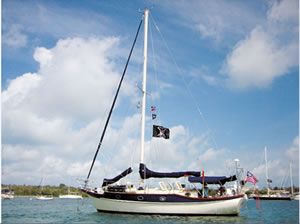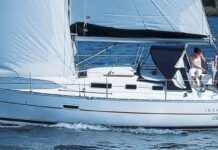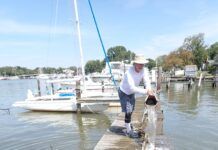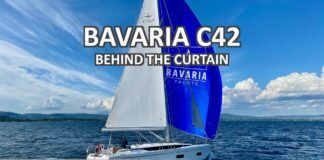
When I see a boat flying the Jolly Roger, I assume that the owner is ignorant of the murders of and terror wreaked on sailors by pirates in recent years, or perhaps just thoughtless. But I was shocked to see such a boat pictured on your front cover of the December 2014 issue.
The owner of that boat, which is flying the Bahamas courtesy flag, and therefore appears to be outside the U.S., also is not following flag etiquette regarding the use of the yacht ensign, which mustnever be flown in international or foreign waters since it has no standing as a national ensign. (U.S. Power Squadrons website, www.usps.org).
Ernest L. Godshalk
Golden Eye, Hinckley SW 42
Manchester-by-the-Sea,
Massachusetts
Presently in Europe
In regard to your When Splicing Isnt an Option blog post (Aug. 4, 2014): Since Dacron is not UV stable, could one use a Nylon thread instead?
Browne Altman
Via email
Our understanding is that Dacron is generally more UV stable than nylon. Also, nylon is too stretchy for sewing high-load splices in rope or webbing, resulting in poor distribution of load. We tested nylon for both whippings and stitching, and it performed so badly that we did not recommend it for any application (see Practical Sailor, October 2014 online). For long-term testing, we have samples of both whipping twine, hand-sewn products and coated products mounted outdoors, exposed to the weather. In a few years, well strength test them and report on their durability.
The two jobs Ive struggled to get good advice on and recommendations for are marine mattresses (we need custom mattresses made, but want them to be long lasting, comfortable, and as protected from humidity/damp as possible) and cabin sofa cushions. I did a search but I couldnt see any PS articles on such providers (good or bad); are you aware of anything? In the past, weve had mattresses that had a vinyl bottom to protect from damp, but that doesn’t seem to be done any longer.
Maryanne Webb
Begonia
Via email
We last tested marine mattresses in the Oct. 15, 2004 issue. You can access the article at www.practical-sailor.com (search for Boat Berth Bazaar), and it should answer your questions. The test included a product called Hypervent (www.hyperventmarine.com), a mat material placed under mattresses to increase ventilation and reduce dampness. In the July 2008 issue, a reader reported that he used the Hypervent mat under his V-berth mattress, and that it completely stopped the underside from getting wet. We also reported on the Froli mattress system (www.froli.com) in the April 15, 2005 issue, and that review is available online.
In regard to your January 2015 PS Advisor on UV protection for Dyneema soft shackles: What would you recoat a Dyneema soft shackle with?
Kenneth Katz
Via www.practical-sailor.com
The Dyneema maintenance market is a relatively new one, and we have not yet tested such products. Wed be hesitant to recommend anything we have not yet tested, but soft-shackle maker Equiplite (www.equiplite.com) hasa coating product availablethat claims to protect Dyneema from UV damage. We plan to put a long-term field test together; stay tuned.
Commenting on the Florida anchoring rights debate (see PS, January 2015 online and Inside Practical Sailor blog, November 2014): I think that we should hammer on the issue that restrictions on anchoring and storage of boats should be based solely on whether those boats are interfering with navigation, or are actively, or in imminent danger of, polluting the waterways. Homeowners should have no say-so, whatsoever, about who parks in front of their houses, or for how long. There is an infamous anchorage in Miami where a homeowner has taken extraordinary actions, including populating the anchorage with his own flotilla of small boats, to keep out others. Homeowners do not own the public waterways.
Ralph Caruso
Via Inside Practical Sailor
In regard to your August 2014 PS Advisor on VHF options for those with hearing impairment: While I appreciate the fact that future VHFs will be Bluetooth-enabled, I will probably not be upgrading my $5,000/pair of hearing aids to the $8,000/pair, Bluetooth-supported hearing aids for a few more years. I believe the best option would be to select the VHF radio brand preferred, and then contact the manufacturer for suggestions/modifications necessary for adding an external headset.
G.W. Wadley
Via email
Im following your series of articles on marine SSB radios (see PS, November and December 2014 online) with great interest. We have an Icom M802 on board, in part to access Chris Parkers weather information, and in part to handle email while were in the Bahamas.
We use a KISS-SSB counterpoise. Copper strips forming a ground plane are impractical (not enough access to lay out a usable system). And I see too many arguments against Dynaplates (drag, pores filled with algae). Despite many naysayers comments to the contrary, the KISS-SSB works, in the water and on the hard. The same chorus of naysayers said the M802 was a bad choice. The radio works in spite of their dire predictions and warnings about clipping, etc.
We have been through a definite learning curve, and traversing parts of it were very expensive. One of the cheap parts was learning how to install ferrite chokes, in lots of unexpected places, to limit RF interference. The cost rose as unprotected USB cables picked up RF energy and basically toasted our laptops USB ports. The cost went through the cabin overhead when the original M802 literally burned up.
A massive arc, caused by the alternator voltage regulator shorting internally, induced out-of-spec excess voltage in our M802. Capacitors popped, and wiring and PC board traces melted. A massive attaboy to Gary Jensen of Dockside Radio for getting us a great deal on a factory-refurbished M802 to replace the original radio.
Before I applied power to the new radio, I installed a battery booster to ensure that a constant 14 volts is supplied to the radio regardless of the battery voltage. More importantly, I added a crowbar circuit to disconnect DC power to the radio in the event it goes over 15.2 volts. If the crowbar circuit sees voltage above the set point, it keeps the excess voltage from reaching the radio. Fuses inside the crowbar circuit pop, to protect the boat wiring from short circuit. Both units came from TG Electronics, an excellent supplier.
The big takeaway here is that Icom supplies no electrical protection for the M802. That is, there are no filters to limit or remove transients or otherwise keep the radio from failing because of, for example, the high voltages appearing during battery equalization.
The voltage booster has two roles. First, it ensures the radio sees at least 14 volts regardless of the voltage being supplied to the booster; that means, should the boats batteries be fading-perhaps in an emergency-the radio will still get its full voltage. If the input is 14 volts or greater, the booster simply passes the voltage along.
During our first trip to the Bahamas with the M802, we used Sailmail for our alternative e-mail path (the primary path was WiFi or, in the States, a cell connection). On this trip, were using Winlink, the amateur radio or ham equivalent of Sailmail. Im rapidly finding that you get what you pay for. With Sailmail, we were able to receive and send email daily with at least 80- to 90-percent success. We paid $200+ for a year of service. With Winlink, which is free to ham operators, the odds of making contact have dropped to somewhere in the 60- to 80-percent range.
With Sailmail, we could generally reach a shore station without too much effort. With Winlink, and operating as a ham, reaching a shore station is harder and there is an FCC-imposed data speed limit. The concern with data speed isn’t a product of wanting bragging rights over data speed. The faster data moves, the shorter the duration of the radio contact. The shorter the duration of the contact, the less power is drawn, from the boats batteries, by the radio as it sends and receives data. The FCC imposed a limit on data rates in the range of frequencies used by marine SSB radios. The American Radio Relay Leage (ARRL) is trying to get this speed limit lifted, but I doubt the FCC will change the rules any time soon.
Richard B. Emerson
One With The Wind
Via email
Due to a printing error, the article index printed in the December 2014 issue was from the previous year.
Amerlock2, a two-part paint made by Amercoat, is not used inside municipal water towers. The December 2014 article on painting water tanks reported differently.






































